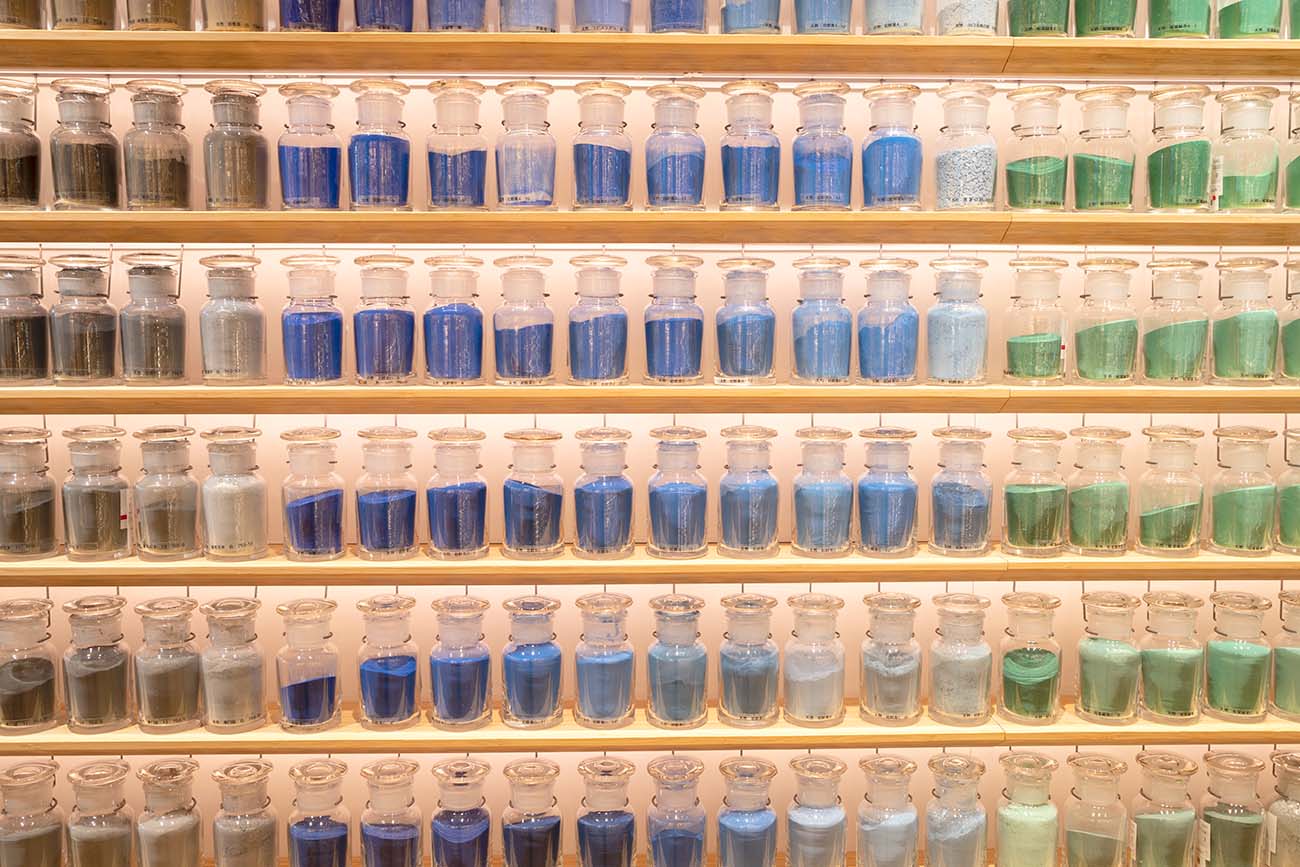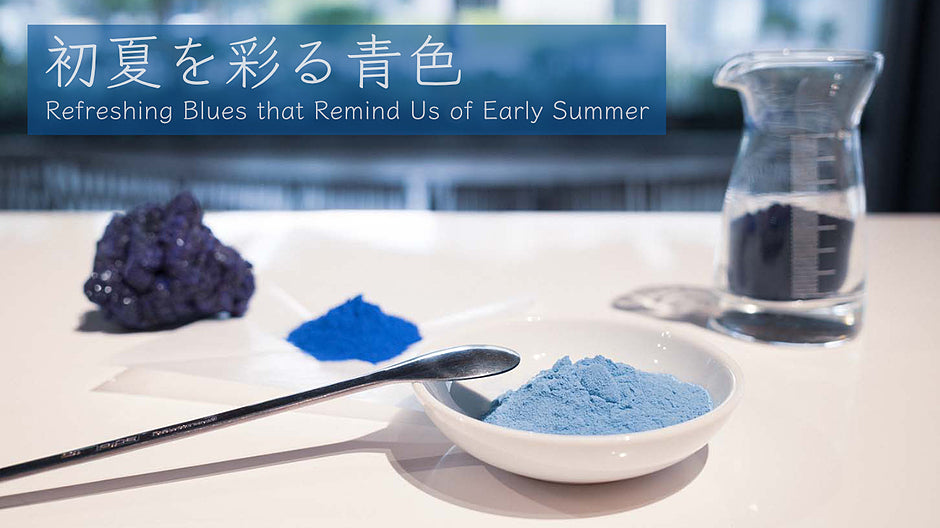As you all know, PIGMENT TOKYO offers a wide variety of pigments from all around the world.
These pigments come in different forms such as color powders made from ground minerals, pigment flakes made by coloring Gofun (胡粉, oyster shell powder) called Suihi (水干, tinted pigments), and pigments with fine particles and vivid colors.
In addition, pigments do not come with simple color names such as red, blue, yellow, etc., like the paints that are commonly used in schools, even some of them have unusual names.
In this article, I would like to change the topic a little and pick up some blue pigments with the theme of "early summer".
The following images are the "blues" that I'm going to introduce today. Can you guess what the names are given to each of them?
Without further ado, let's take a look at them in order, starting with the blue color on the left.

・Natural Gunjo
Gunjo is one of the most popular blue colors in mineral pigments and has been used throughout the ages in various parts of the world.
Since "Gunjo(群青)" sometimes refers as Ultramarine blue derived from Lapis Lazuli and synthetic Ultramarine blue from Kaolinite, therefore, Natural Gunjo blue made from Azurite is usually called "Iwa-gunjo(岩群青, Iwa means mineral ores in Japanese)."
As a characteristic of this kind of pigment, a number is assigned to the color name, and the larger the number, the finer the particles become and the more reflective they become, which results in a lighter, whiter appearance.
This color change can only be found with mineral pigments.
When using gum arabic or acrylic emulsions as a binder, it is recommended to use pigments with at least a no.11 or finer particle sizes.
The larger the particle size, the rougher the texture of the mineral pigments will be, making it difficult to use with other paints and pigments.
Therefore, for those of you who want to try coarser mineral pigments, it is better to start from no.11 or lower.

In PIGMENT TOKYO, we provide several options of Gunjo blue pigments with different grades. If you are interested but couldn’t make it to the store in person, feel free to contact us through our contact form on our online store.
・Kissho Mizu Asagi
Kisso Mizu Asagi is another blue mineral pigment that is commonly used in Japanese painting.
However, unlike the natural mineral pigments mentioned above, these are made from artificial lead glass and are called Shin-iwa-enogu (新岩絵具) or Artificial Mineral Pigments.
What makes Shin-iwa-enogu so special is their huge range of coloration. They produce colors that cannot be found in natural minerals, making them possible to create highly saturated paintings.
The name Mizu Asagi comes from the Japanese word "Asagi (浅葱)," which means the color of a light leek leaf. It also has a meaning of light indigo or light blue with greenish tints.
As with the above, when using gum arabic or acrylic emulsion as a binder, it is best to use finely grained pigments.

As the particle sizes become finer, we can see the brightness of the colors increase.
・Suihi Usu Gunjo
Unlike Iwa-enogu (mineral pigments) and Shin-iwa-enogu (artificial mineral pigments), the flakes of this pigment are made from Gofun (胡粉, a white pigment made from Itabo oyster shells) that has been dried and colored.
Therefore, although it comes with a Japanese name, it has completely different properties from Iwa-enogu and Shin-iwa-enogu.
Moreover, the particles are so fine that it is possible to mix colors between Suihi pigments, and since it is cheaper and can be applied more evenly than Iwa-enogu, it is often used as a base coat for large paintings.
To make it easier to mix with binders, use a mortar and pestle to finely grind the pigments before use.

A view of a Suihi pigment bottle from above.
・Prussian Blue
Unlike the pigments I have introduced so far, this type of pigment has no variety in particle sizes and there is no need to use a mortar and pestle like with Suihi pigments.
These fine pigments are designed to be mixed with acrylic emulsions and oil-based mediums, no doubt they can also be mixed with animal glue for Japanese paintings.
Prussian blue, also known as Bero-ai (ベロ藍) in Japanese, was first discovered in Europe in the 1700s and imported to Japan during the Edo period. It is also known as Hokusai blue because Hokusai Katsushika (葛飾北斎, an Ukiyo-e Japanese artist) used it in his woodblock prints.
Although the brightness of the pigment itself is not as high as mineral pigments, it can be diluted with water or mixed with white pigments. Moreover, due to the strong coloration, it’s better to be extra careful with the amount of the pigment while using it.

In PIGMENT TOKYO, we carry fine pigments from different manufacturers such as Holbein, Matsuda, Kusakabe, Schmincke and Zecchi, therefore, that goes the same with Prussian Blue pigments.
Is there any color that caught your eyes?
Choosing a color or pigment can be as fun as you were choosing clothes or accessories for the seasons.
For more information on making transparent watercolors, please refer to the following article.
「Creating Your Own Transparent Watercolors」
https://pigment.tokyo/en/blogs/article/95
You can also learn how to make acrylic paints using pigment pastes in the article below.
「Create Your Own Acrylics!」
https://pigment.tokyo/en/blogs/article/109
If you would like to get advice from our art experts, I also recommend our “Creating Original Paints” workshop.









